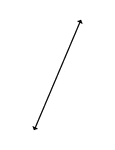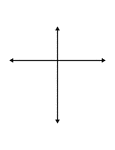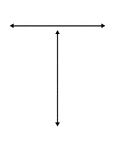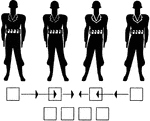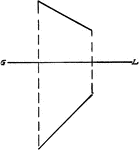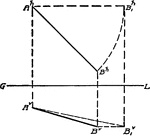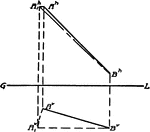
Construction Of Dividing A Line
Illustration used to show how to divide a given straight line into required number of equal parts.
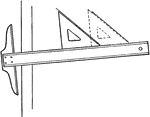
Drawing Parallel Lines Using T-square and Triangle
Parallel lines are drawn by holding the triangle against the T-square at an angle, or another triangle,…
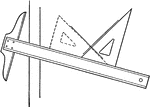
Drawing Perpendicular Lines Using T-square and Triangle
Perpendicular lines are drawn by fitting the hypothenuse of the triangle to the T-square at an angle,…

Angle of Elevation
Illustration showing an angle of elevation from a horizontal line to a line of sight.

Tangent to an Ellipse
Diagram an ellipse with a tangent line that illustrates "A line through a point on the ellipse and bisecting…

Line Divided Into Equal Parts
Illustration used to show how to divide a given straight line into any number of equal parts.
Construction Of Equilateral Triangle
Illustration used to show how to draw an equilateral triangle when given one side.
Construction Of Equilateral Triangle
Illustration used to show how to draw an equilateral triangle when given the altitude.
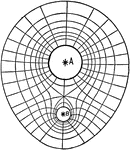
Equipotential Lines
"When a charge is moved from any point to another point in the same equipotential surface, no work is…
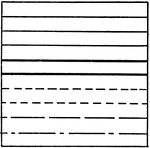
Horizontal Solid and Dashed Line Drawing Exercise
An exercise for mechanical drawing to construct a series of horizontal lines. The solid lines are drawn…

Horizontal Solid Line Drawing Exercise
An exercise problem drawing a series of horizontal lines using a straight edge or triangle without using…
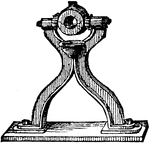
Floor Hanger
"A shaft-bearing secured to the floor, and used for running countershafts and lines when they cannot…

Metal Centrifugal Governor Ball Height Gage
The illustration showing the centrifugal governor metal ball removed from the lathe to draw 180 degree…
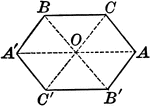
Axis of Symmetry Drawn on a Hexagon
Illustration of an axis of symmetry drawn with respect to a hexagon.

Axis of Symmetry Drawn on a Hexagon
Illustration of an axis of symmetry drawn with respect to a hexagon.
Segment, Horizontal Line
Illustration of a horizontal line segment. A line segment is a section of a line with definite endpoints.
Segment, Horizontal Line
Illustration of a horizontal line segment. A line segment is a section of a line with definite endpoints.
Segment, Horizontal Line
Illustration of a horizontal line segment. A line segment is a section of a line with definite endpoints.…

Sketching Horizontal Line
Horizontal line can be drawn left to right by holding the pencil away from the point.
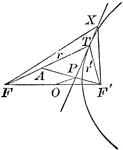
Tangent to a Hyperbola
Diagram part of a hyperbola with a tangent line that illustrates "A line through a point on the hyperbola…
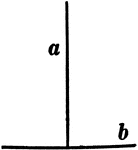
Optical Illusions
Illustration showing optical illusions. It is not always possible to trust the eye to be sure if the…

Optical Illusions
Illustration showing optical illusions. It is not always possible to trust the eye to be sure if the…
Optical Illusions
Illustration showing optical illusions. It is not always possible to trust the eye to be sure if the…

Optical Illusions
Illustration showing optical illusions. It is not always possible to trust the eye to be sure if the…
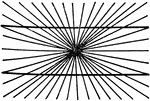
Optical Illusions
Illustration showing optical illusions. It is not always possible to trust the eye to be sure if the…

Optical Illusions
Illustration showing optical illusions. It is not always possible to trust the eye to be sure if the…
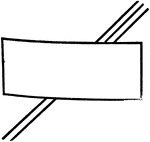
Optical Illusions
Illustration showing optical illusions. It is not always possible to trust the eye to be sure if the…
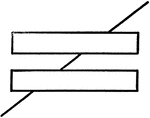
Optical Illusions
Illustration showing optical illusions. It is not always possible to trust the eye to be sure if the…

Lines of Force under Induction
"Lines of force of a charged sphere and a conductor under induction. The negative electrification on…
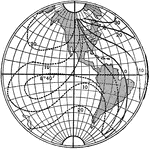
Isogonic Lines of Earth
"The magnetic poles of the earth do notc oincide with its geographical poles and, condequently, in some…

Vertical Line of Symmetry, Isosceles Triangle With
Isosceles Triangle with a dotted vertical line that is a line of symmetry.
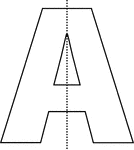
Vertical Line of Symmetry, Letter A With
Letter A with a dotted vertical line that is a line of symmetry.

Horizontal Line of Symmetry, Letter B With
Letter B with a dotted horizontal line that is a line of symmetry.
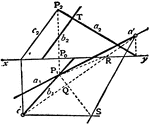
Angle of Two Lines
To find the angle between two given lines a, b of which the projections a1, b1 and a2, b2 are given.

Construction Of Line Equal To Arc
Illustration used to show how to find a straight line of the same length as a given arc of a circle.

Midpoint of Straight Line Drawn From an Exterior point to Circumference
Illustration showing a line with a midpoint drawn from a given exterior point to a given circumference.

Straight Line Moving to Two circles
Illustration showing a line that remains parallel to a given line, and touches at one end a given circumference.
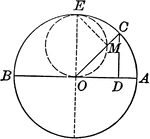
Circle Made by Ends of a Line Touching Two Fixed Lines Perpendicular to Each Other
Illustration showing a line that moves so that its ends constantly touch two fixed lines which are perpendicular…

Perpendicular Line Drawn To a Given Line From an External Point
Illustration showing that the perpendicular is the shortest line that can be drawn to a straight line…

Projection of a Line
Illustration of a line projection. If perpendiculars be drawn from the extremities of a line, as AB,…
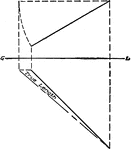
Projections of a Line
Projections of a line inclined to both the horizontal and vertical planes will not show its true length,…
